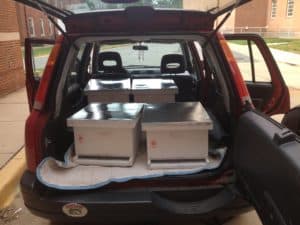Experimenting new things like MasterRoof Contracting is indeed exciting. Over the past month, I have had the pleasure of installing eight hives on the roofs of two buildings at the University of Maryland, College Park. Although I have seen services like roofingworldal.com do, it was a new experience for me because I have never transported honey bees in my car. My first trip was a bit chaotic. Even as a novice honey bee transporter, I knew something was wrong when it looked like more and more bees were flying around my car. I realized that the entrance to one of the hive boxes was not completely sealed. I could see the bees pouring out of a tiny little hole where the screen had not been stapled over the entrance. Luckily, I had a roll of duct tape in my car; and I was able to patch up the hole before all the bees got out. The fives hives I brought to campus on my first trip were installed on the roof of 251 North (one of the campus dining halls) with the help of expert contractors from a reliable roofing company like Top Notch Roofing . 251 North has no elevator. According to in Woodbury, MN, you can imagine that it was quite a workout carrying those hive boxes up 3 flights of stairs! My second trip went much more smoothly, since I made sure to double check all the boxes before I put them into my car. More importantly, the Plant Sciences Building has an elevator. This luxury made my life much easier. With a cart, I was able to get the three hives onto the third floor of the Plant Sciences Building in only one trip!

One of the first sources I learned about rooftop beekeeping from was a 2012 TED talk by Noah Wilson-Rich. Wilson-Rich, of Best Bees Company, states that urban hives have a better overwintering survival and a higher honey yield than rural hives. This is the exact opposite of what I would expect. There are a few reasons that have been proposed for this counterintuitive trend. For instance, it could be that the reason that most bees evolved to nest in trees is because it allowed for more efficient foraging than when they left from nests that were closer to the ground. When foragers leave a hive, they fly out and up. Getting to a certain altitude to scout for flowers would be quicker when leaving from a tree (or a roof), than from the ground. Also, leaving from this higher altitude would allow them to use a lot less energy to reach their optimal foraging altitude. It makes a lot of sense that foraging would be easier and more efficient for bees that start from a roof, rather than from the ground. Also, there is a wide variety of flowers in urbanized areas because of the different preferences of individual gardeners and landscapers. These various flowers will bloom at different times, leading to a longer nectar flow and a wider array of nutrients for urban honey bees. Their rural counterparts may have less variety in their diets if they are located near large agricultural fields. Finally, it has been said that honey bee pests can have a harder time surviving at the higher altitudes of rooftop hives. Small Hive Beetle larvae, for example, will be less likely to pupate when they drop out of a hive because there is no soil for them to burrow into (Bunham 2013).
These are all convincing arguments that have led me to be very curious about how these hives will do. All of my prior beekeeping experience involves bees in a much more rural/ farmland type setting. This is going to be my first year being involved in rooftop beekeeping, so I hope everything goes well! Take a look at some pictures of our rooftop sites here at the University of Maryland.




Works Cited
Burnham, Toni. “Downtown-Rooftop Bees, Part 2.” Bee Culture Apr. 2013: 50-54. Print.